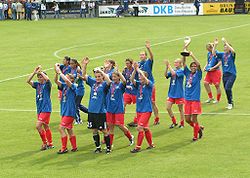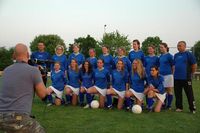Women's association football

Women's association football has been played for a long time, but was associated with charity games and physical exercise in the past before the breakthrough of organized women's association football came in the 1970s. Before the 1970s, association football was mostly seen as a men's game. Association football is the most prominent team sport for women in a few countries, and one of the few women's team sports with professional leagues.
The growth in women's football has seen major competitions being launched at both national and international level. For more information see Women's football around the world and International competitions in women's football respectively. Women's football faced many struggles throughout its fight for right. Although the women's football had its first golden age in the UK in early 1920s when some matches achieved over 50,000 spectators,[1] but this was stopped on 5 December 1921 when England's Football Association voted to ban the game from grounds used by its member clubs. The ban was cancelled in July 1971.
Contents |
History
The Munitionettes' Cup
In August 1917 a tournament was launched for female munition workers' teams in North-East England. Its official title was the "Tyne Wear & Tees Alfred Wood Munition Girls Cup," but it was popularly known as "The Munitionettes' Cup." The first winners of the trophy were Blyth Spartans, who defeated Bolckow, Vaughan 5-0 in a replayed final tie at Middlesbrough on 18 May 1918. The tournament ran for a second year in season 1918-19, the winners being the ladies of Palmer's shipyard in Jarrow, who defeated Christopher Brown's of Hartlepool 1-0 at St James's Park in Newcastle on 22 March 1919.
The English Ladies' Football Association Challenge Cup
Following the Football Association ban on women's teams on 5 December 1921, the English Ladies' Football Association was formed. A silver cup was donated by the first president of the association, Len Bridgett. A total of 24 teams entered the first competition in the spring of 1922. The winners were Stoke Ladies who beat Doncaster and Bentley Ladies 3-1 on 24 June 1922.
The Championship of Great Britain and the World
In 1937 and 1938, the Dick, Kerr's Ladies F.C. played Edinburgh Ladies in the "Championship of Great Britain and the World". Edinburgh Ladies won in 1937, Dick, Kerr's Ladies F.C. 1938.
UEFA Women's Championship
Unofficial women's European tournaments for national teams were held in Italy in 1969 [2] and 1979[3] and won by Italy and Denmark, but there was no formal international tournament until 1982 when the first UEFA European Competition For Representative Women's Teams was launched. The 1984 Finals was won by Sweden. This competition name was succeeded by the UEFA Women's Championship and today, is commonly referred to as the Women's Euro. Norway won, in the 1987 Finals. Since then, the UEFA Women's Championship has been dominated by Germany, which has won seven out of eight events, interrupted only by Norway in 1993. Germany's 2009 win was their fifth in a row.
Women's World Cup

Prior to the FIFA's 1991 establishment of the Women's World Cup, several unofficial world tournaments took place in 1970s and 1980s,[4] including the FIFA's Women's Invitation Tournament 1988, which was hosted in Taiwan.[5]
The first Women's World Cup was held in the People's Republic of China in November 1991, and was won by the USA. The third Cup, held in the United States in June-July 1999, drew worldwide television interest and a final in front of a record-setting 90,000+ Los Angeles crowd, where the USA won 5-4 on penalty kicks against the People's Republic of China.
Copa Libertadores de Fútbol Femenino
The Copa Libertadores de Fútbol Femenino (Women's Libertadores Cup) is the international women's football club competition for teams that play in CONMEBOL nations. The competition started in the 2009 season in response to the increased interest in women's football. It is the only CONMEBOL club competition for women, and it is sometimes called the Copa Libertadores Femenina.
FIFA Women's Club World Cup

FIFA announces in 2010 the first edition of the FIFA Women's Club World Cup. There is still no official date for the tournament, but is expected to happen in April or May.
In a meeting at FIFA's headquarters, a Women's Football Commission approved the holding of the first Women's Club World Cup, officiating its implementation in Brazil, in the city of Santos, São Paulo's coast, in April or May[6].
Now the 6 continental confederations associated to FIFA - CONMEBOL - South American Football Confederation (Women's Libertadores Cup); UEFA - Union of European Football Associations (UEFA Women's Champions League); AFC - Asian Football Confederation; CAF - Confederation of African Football; CONCACAF - Confederation of North, Central American and Caribbean Association Football; e OFC - Oceania Football Confederation - have until January to indicate the teams that will compete in the tournament.
Olympics
For the 1996 established Women's Olympic Football Tournament, given the general abandonment of amateur regulations in the Olympic Games in the 1990s, the national women's teams do not have restrictions due to professionalism or age; thus, the tournament becomes a back-to-back re-World Cup with the best teams of the previous year's World Cup plus the hosts. However, England and other British Home Nations are not eligible to compete as separate entities because the International Olympic Committee does not recognise their FIFA status as separate teams in competitions. The participation of UK men's and women's sides at the 2012 Olympic tournament was a bone of contention between the four national associations in the UK from 2005, when the Games were awarded to London, to 2009. England was strongly in favour of unified UK teams, while Scotland, Wales, and Northern Ireland were opposed, fearing adverse consequences for the independent status of the Home Nations within FIFA. Eventually, a compromise was reached by which England alone will field teams under the UK banner (officially "Great Britain") for the 2012 Games.[7]
Youth and amateur
Youth tournaments
Besides the United States and Germany (which won the 2003 and 2007 World Cups), the strongest women's teams have traditionally been Norway, China, and Sweden, with nations like Brazil emerging as powers.
In 2002, FIFA inaugurated a women's youth championship, officially called the FIFA U-19 Women's World Championship. The first event was hosted by Canada. The final was an all-CONCACAF affair, with the USA defeating the host Canadians 1-0 with an extra-time golden goal. The second event was held in Thailand in 2004 and won by Germany. The age limit was raised to 20, starting with the 2006 event held in Russia. Demonstrating the increasing global reach of the women's game, the winners of this event were North Korea. The tournament was renamed the FIFA U-20 Women's World Cup, effective with the 2008 edition won by the USA in Chile.
In 2008, FIFA instituted an under-17 world championship. The inaugural event, held in New Zealand, was won by North Korea.
Intercollegiate
United States
In the United States, the intercollegiate sport began from physical education programs that helped establish organized teams. After sixty years of trying to gain social acceptance women's football was introduced to the college level. In the late 1970s, women's club teams started to appear on college campus, but it wasn't until the 1980s that they started to gain recognition and gained a varsity status. Brown University was the first college to grant full varsity level status to their women's soccer team. The Association of Intercollegiate Athletics for Women(AIWA), sponsored the first regional women's soccer tournament at college in the USA, which was held at Brown University. The first national level tournament was held at Colorado College, which gained official AIAW sponsorship in 1981. The 1990s saw greater participation mainly due to the Title IX of 23 June 1972, which increases school's budgets and their addition of women's scholarships.
"Currently there are over 700 intercollegiate women's soccer teams playing for many types and sizes of colleges and universities. This includes colleges and universities that are members of the National Collegiate Athletic Association (NCAA), National Association of Intercollegiate Athletics (NAIA), and the National Junior College Athletic Association (NJCAA)."
Attire

In September 2008 FC de Rakt women's team (FC de Rakt DA1) in the Netherlands made international headlines by swapping its old kit for a new one featuring short skirts and tight-fitting shirts.[8] This innovation, which had been requested by the team itself, was initially vetoed by the Royal Dutch Football Association on the grounds that according to the rules of the game shorts must be worn by all players, both male and female; but this decision was reversed when it was revealed that the FC de Rakt team were wearing hot pants under their skirts, and were therefore technically in compliance. Denying that the kit change is merely a publicity stunt, club chairman Jan van den Elzen told Reuters:
The girls asked us if they could make a team and asked specifically to play in skirts. We said we'd try but we didn't expect to get permission for that. We've seen reactions from Belgium and Germany already saying this could be something for them. Many girls would like to play in skirts but didn't think it was possible.
21-year-old team captain Rinske Temming said:
We think they are far more elegant than the traditional shorts and furthermore they are more comfortable because the shorts are made for men. It's more about being elegant, not sexy. Female football is not so popular at the moment. In the Netherlands there's an image that it's more for men, but we hope that can change.
Hooliganism
In 2000, during the 2000 Women's African Cup of Nations final, Nigeria scored a controversial goal that many felt was offside. South African fans began throwing bottles at Nigerian players and started fights. Riot police had to come in and the game was abandoned. The Cup was awarded to Nigeria.
See also
- List of women's association football clubs
- Women's sports
- Title IX
- List of football (soccer) players
- Women's football around the world
- Football pools
- Gracie
- Bend it Like Beckham
- International competitions in women's football
References
- ↑ "Trail-blazers who pioneered women's football". BBC News. 2005-06-03. http://news.bbc.co.uk/sport1/hi/football/women/4603149.stm. Retrieved 2010-02-19.
- ↑ "Coppa Europa per Nazioni (Women) 1969". Rsssf.com. 2001-03-19. http://www.rsssf.com/tablese/eur-women69.html. Retrieved 2009-09-12.
- ↑ "Inofficial European Women Championship 1979". Rsssf.com. 2000-10-15. http://www.rsssf.com/tablese/eur-women79.html. Retrieved 2009-09-12.
- ↑ "Women's World Cup". Rsssf.com. 2008-07-03. http://www.rsssf.com/tablesw/women-worldcup.html. Retrieved 2009-09-12.
- ↑ "Rec.Sport.Soccer Statistics Foundation — Women's FIFA Invitational Tournament 1988". Rsssf.com. 2007-07-06. http://www.rsssf.com/tablesw/wom-fifa88.html. Retrieved 2009-09-12.
- ↑ http://globoesporte.globo.com/Esportes/Noticias/Times/Santos/0,,MUL1359774-9874,00.html Santos sediará primeiro Mundial de Clubes Feminino em 2010
- ↑ "England to go solo with 2012 Olympic team?". ESPNsoccernet. 2009-05-29. http://soccernet.espn.go.com/news/story?id=650708&sec=england&cc=5901. Retrieved 2009-05-29.
- ↑ "Football: Said and Done, The Observer (London); Sep 21, 2008; David Hills; p. 15". Guardian. 2008-09-21. http://www.guardian.co.uk/football/2008/sep/21/2. Retrieved 2009-09-12.
Further reading
- In a League of Their Own! The Dick, Kerr Ladies 1917-1965. ISBN 1-85727-029-0.
External links
- Women's Football Official Video Site
- Dick, Kerr Ladies FC
- FIFA Women's
- Women's World Football
- "USA-North Korea: Seeds of a New Women's Football Rivalry Are Sown" (December 2008)
- Women's Football Forums
- femaleSOCCER.net - UK girls and women's football
- Fair Game Magazine site - source of information on British women's football
- W-League - USA professional women's soccer/football
- Women's United Soccer Association (historic content, now defunct - USA)
- Spanish Female soccer
- Women's Premier Soccer League (USA semi-pro)
- Upfront - a voice for female football fans
- FemaleFan
- Yahoo! Directory: Women's Football
- Pink Football's News on the Women's Game
- Directory of Women's and Girl's football Teams
- Women Football in Venezuela (South America)
- Women's 5 a-side leagues
- Women's Football History
- Women's Football in Videogame? - Voting Poll
- Russian women's football
|
|||||||||||||||||
|
|||||||||||||||||||||||||||||
|
|||||
